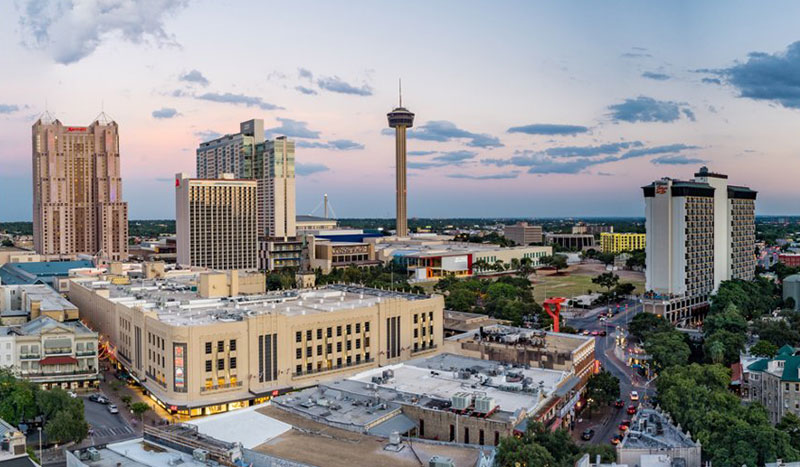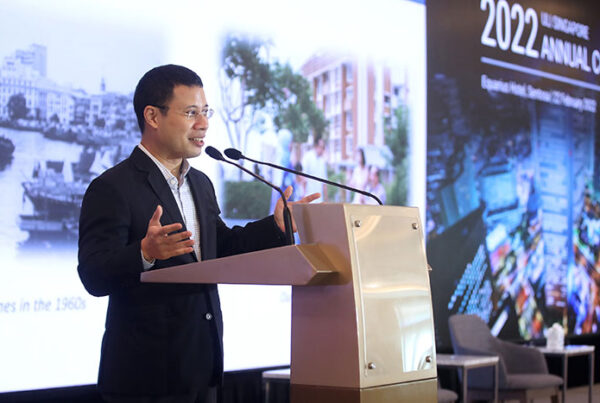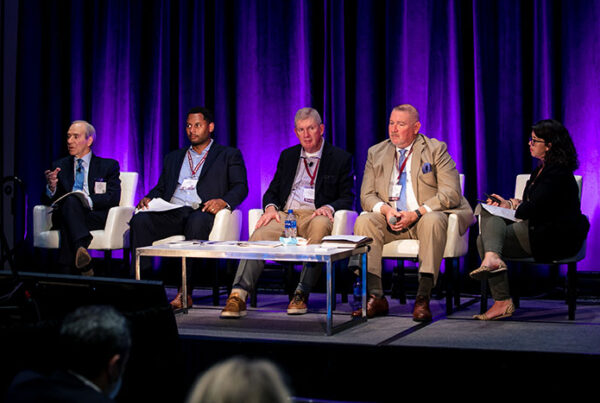
The Hemisfair District in San Antonio, Texas.
The University of Texas at San Antonio (UTSA) can create a new vision for its Institute of Texan Cultures (ITC) that advances the museum’s mission, strengthens the university’s presence in the Hemisfair District, and supports the San Antonio community, according to a report released by ULI.
The report is based on recommendations from a panel of land-use and resilience experts convened in June through the Institute’s virtual Advisory Services Panel (vASP) offering. The virtual panel is a multi-day program that is tailored to meet a community’s specific needs, wherein ULI representatives hold in-depth interviews with local stakeholders and deliberate on potential courses of action before making a final presentation of their recommendations.
The panel was tasked by UTSA with exploring land use considerations to help inform a community stakeholder visioning process for ITC Centennial 2068, a community-based process currently underway at the university. Originally built as the Texas Pavilion for the 1968 World’s Fair, commonly known as HemisFair ’68, the ITC was not constructed with its current uses as a museum and educational center in mind. The current building is not easily accessible from San Antonio’s tourist destinations. But as a landmark, historic property, the facility has become a symbol of Texan cultures and a nostalgic reminder of the World’s Fair.
The panel offered considerations in line with three overarching objectives: advancing the ITC’s mission, maintaining stewardship of the existing site, and ensuring the ITC’s location contributes positively to Hemisfair in the long term. The report elaborates on the panel’s key recommendations:
- Recognize that the ITC’s mission, site location, and building are distinct considerations from the use of the Texas Pavilion and require separate decisions. By focusing specifically on the ITC’s future, UTSA can help the ITC thrive and meet the needs of an ever-evolving San Antonio.
- Find a new Hemisfair location and building for the ITC that better support future institutional priorities, better integrate with the Hemisfair campus and increase community and visitor access.
- Integrate the existing UTSA site with Hemisfair. Enable new uses of the current site that support the Hemisfair campus and the city’s tourism and hospitality industries.
- Build and strengthen partnerships among UTSA, Hemisfair, and the city of San Antonio.
The panel was chaired by Jeanne Myerson, principal, The Belgrave Group, San Francisco, Calif. “UTSA has several rare opportunities; among them is the chance to transform the ITC into a state-of-the-art home for supporting the many facets of San Antonio’s vibrant communities through better connections with university resources, for ITC to become the convenor of robust conversations about the region’s future and a dynamic location for San Antonio residents to come together for life-long learning,” Myerson said. “By spearheading an inclusive and community-oriented process for redevelopment, UTSA can, in partnership with Hemisfair and the City of San Antonio, transform this underutilized site to maximize the potential of the entire Hemisfair property and make a powerful contribution to the city’s economic vitality.”
Myerson was joined on the panel by Martha Clifford, associate, Office of Cheryl Barton, San Francisco, Calif.; David Greenbaum, principal, cultural planning at David B. Greenbaum, Bethesda, Md.; Todd Mead, principal, Office of Cheryl Barton, San Francisco, Calif.; Wellington “Duke” Reiter, senior advisor to the president, Arizona State University, Tempe, Ariz.; Christine Richman, principal, GSBS Architects, Salt Lake City, Utah; Monte Ritchey, president, Conformity Corporation, Charlotte, N.C.; Marsha Semmel, principal, Marsha Semmel Consulting, Arlington, Va.; and Michael Stevens, president, Capitol Riverfront BID, Washington, D.C. The panel met with over 70 San Antonio community leaders and stakeholders as part of their work.
Virtual Advisory Services panels (vASP) were launched in 2020 as a new Advisory Services offering, created as a response to continuing ULI’s mission of creating vibrant, sustainable communities during the COVID-19 pandemic. Lasting several days, they convene a multi-disciplinary panel of experts from across the United States who possess a range of professional backgrounds and use their collective skills to meet the needs of an identified land use or policy challenge.
Since 1947, the ULI Advisory Services program has assembled experts in the fields of real estate and land use planning to participate on panels worldwide, offering recommendations for complex planning and development projects, programs, and policies. Panels have developed more than 700 studies for a broad range of land uses.
According to Thomas Eitler, senior vice president of ULI’s Advisory Services program, the strength of the program lies in ULI’s unique ability to draw on the substantial knowledge of its 45,000-plus members, including land developers, engineers, public officials, academics, lenders, architects, planners, and urban designers. “The independent views of the panelists bring a fresh perspective to the land use challenge,” Eitler said. “The Advisory Services program is all about offering creative, innovative approaches to community building.”
The UTSA’s Institute of Texan Cultures, San Antonio, Texas, virtual Advisory Services Panel report can be found on ULI’s Knowledge Finder Platform, as well as the ITC Centennial 2068 website.



